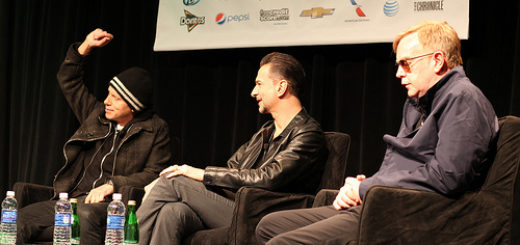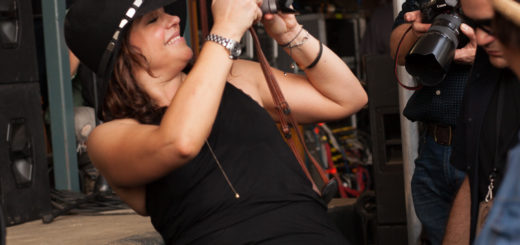Graveyard Shift Shorts x2 @Nashville Film Festival
Nashville Film Festival Coverage via Jason Sparks, Our Man In Nashville
The second night of Graveyard Shift shorts was, like the first night, an eclectic mix of horror, comedy, and surrealism; the second night, however, delivered harder, scarier punches, if you will, especially with the last short of the night.
The program began with Ben Botwick’s film Bells, which clocks in at six minutes in length. As you can surely imagine, when a film is only six minutes long, there’s little you can say without giving spoilers. I will say this: it’s the story of a young boy who hangs sleigh bells from his bedroom door at night, as a sort of early warning system lest monsters enter his room. One night, his father advises him that he might also consider alarming his closet door…and that’s all I’m going to say, except that in six minutes, this film delivers the same existential dread that the best campfire ghost stories tend to deliver. Destin Khari, as the young boy, conveys every bit of that dread; Heinley Gaspard, playing the father, delivers the oh-come-on-now mindset so common to dads in this situation, as well as a tinge of menace (which may, or may not, be a misdirect.)
After Bells came a 2017 short by Steve Daniels called Blood Spook, which exists at the tipping point of horror and comedy. Blood Spook follows a diabetic trucker (A.J. Bowen) who finds himself frequently stopping at truck stops serviced by “lot lizards” (trucker slang for prostitutes). Unfortunately, the “lizards” are being murdered. Is our truck driver the killer? Is he even really a truck driver? And why does he keep flashing back to a time in his childhood when he dug up a woman’s grave? More to the point, why does the de-buried woman in question keep appearing in the rest rooms at the truck stops, at around the same time that the lot lizards are killed? It’s a taut 21 minutes, during which you keep guessing, and it depicts truck stops in all their real sketchy glory—the soundtrack even includes music by Gene Tracy, an X-rated comic who catered almost exclusively to truckers.
If Blood Spook exists at the tipping point between horror and comedy, Jon Park and Grant White’s Black Shore exists at the tipping point of horror and more horror and even more horror, until it swan-dives right off of that tipping point. Black Shore is a coastal English town, where Ben (Matthew Steer) and his son (Austin Taylor) live. Ben’s wife Holly (Jessica Raine) used to live there as well, until she disappeared; despite her disappearance, Ben receives a letter from her every day—the exact same letter, over and over, telling him to meet her at a shuttered cafeteria. She’s never there, nor does Ben ever see who’s bringing the letters, until the day that he does see Holly again. What he sees, where she is, and what happens to Ben and his son as a result is reminiscent of what happens when Dave Bowman finally encounters the monolith in 2001: A Space Odysssey—it’s harrowing, it’s beautiful, it’s inexplicable, and it’s best viewed on a big screen.
Following Black Shore was Boys’ Club by Troy DeWinne, which takes place in a world beset by a zombie apocalypse. There have been, suffice to say, plenty of movies about a zombie apocalypse; there have, however, not been many movies about a zombie apocalypse in which one of the characters is a masturbation addict, and even fewer zombie apocalypse movies in which an inflatable sex doll is a plot point—and, to some degree, a character. The masturbation addict is Tyler (Elias Hinojosa), one of two survivors living in a bomb shelter beneath a farm; keeping tabs on the outside world via periscope, Tyler sees an old man drive onto the farm grounds. In the passenger seat of his truck is the sex doll, which the old man briefly leaves alone in the truck; Tyler knows that leaving the shelter puts him at risk of zombie attack. But sex doll. It’s a neat mixture of horror and cringe comedy.
We’ve seen horror function at the tipping point of comedy, cringe comedy, and more horror; can it also exist at the tipping point of canonical literature? Yes, it can, in Stephanie Szerlip’s The Follower, about a teenage girl who posts risque selfies on social media. Grounded and alone at her house (her mother has seen the pics), she finally meets her most devoted follower—to her nearly immediate regret. As I watched the film, I realized that it reminded me of something, and when the credits rolled, I learned I was right. It’s an adaptation of Where Are You Going, And Where Have You Been?, a short story by Joyce Carol Oates; the story is originally set in the fifties, but Szerlip seamlessly adapts it to the 21st century. Logan Polish is excellent as the selfie-posting teen, and Jack Kilmer is pure menace as the follower—well, menace with an initial veneer of charm, much as he has in the original Oates story.
The intense aftertaste of The Follower is washed away by Paul Oh’s Lukewarm Liquids, four minutes of gross-out humor based on a couple scratching each other’s backs (specifically, the…entities on said backs), which will delight any sixth-grader; following that was Meet You In The Parking Lot, by David Sloan and Jordan Eakin. What’s going down in the parking lot? Simple: Sam and Alex, two young women, are creating a massive chalk circle, festooned with a hodgepode of alchemical and horoscope symbols, in which (according to the contents of a notebook they’ve found) they will, if they sit in the center of the circle at a specific date and time, meet their future selves. Do they? Yes. Does it end well? It ends okay for Alex (Gabrielle Stephenson), the one who is skeptical at first; for true believer Sam (Areille Gordon), it ends about as well as time-travel ends in La Jetee and 12 Monkeys. Sloan and Eakin should show this film to Jordan Peele; his Twilight Zone reboot needs directors with the strengths they display here.
Jordan Peele should also see the film that ended the night, 12 minutes of hell called STOP, by Steven DeGennaro. The other films tonight dealt with horrors mostly unreal in nature. This one most assuredly did not. The premise is simple: we’re in a car late at night. The driver (Cameron Jones) is black. A lawyer friend of his (Chris Boykin), in the back seat, is black. The driver’s girlfriend (Jessica Perrin) is white. The car gets pulled over. The policemen are white. You probably see where this is going, and why I think Jordan Peele should see it; the real-life horror of racism in action is something he has explored and nearly won an Oscar for. The thing is, you don’t see where it’s going. It’s 12 minutes of unrelenting suspense and unease, as well it should be; it puts the audience in a position to know how that suspense and unease feel to those for whom it’s real every day. Actually, it’s eleven minutes and fifty seconds of suspense and unease, as we wonder what the police are about to do, until they decide to let the party go with a warning…initially. In those final ten seconds, however, one character delivers one line, and the narrative shift is horribly fast—and it left an audience full of cineastes and horror buffs in stunned silence and, I hope, some epiphany about the realities of race. The film was called STOP, and we all did just that; we came for intense cinema, and damned if we didn’t get it.























Hey Anna
Thank you so much for the write up and the kind words regarding “Blood Spook.” I love that you mentioned Gene Tracy. You are the 1st and only person to do so.